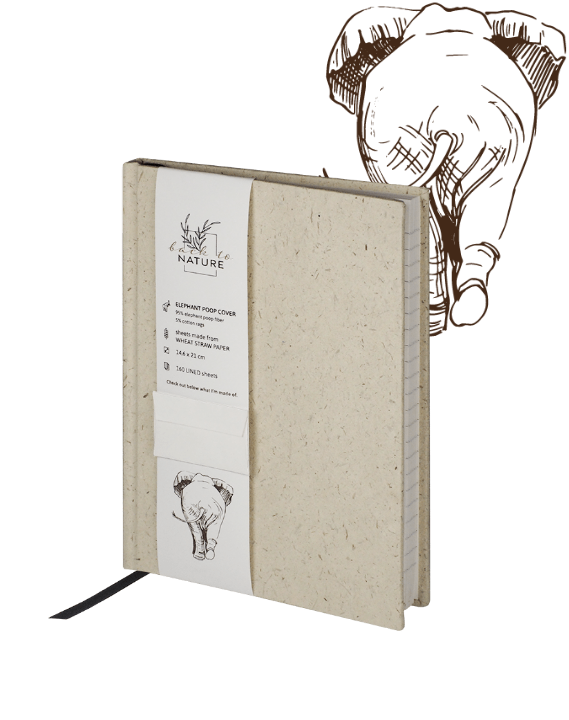Products: Found {{ searchResultsCount }} - Show all
Check if you entered what you are looking for correctly.
Categories: Found {{ categorySearchResults.length }}
CRAFT ECO NOTEBOOKS
From landfills, plantations, coffee and tea factories, parks and reserves. Our treeless notebooks not only help to save forests but also to clean up a bit.
See




THIS IS STILL USEFUL!
An uncle, grandma and grandpa, a brother-in-law - most of us remember or have someone in our family who used to store "junk". Someone who found it difficult to throw away a piece of wire or an old washing machine because, after all, it could still be useful somehow. And this was often the case. In the past, almost nothing was disposable. Family items and appliances were repaired and improved at the family's own expense, giving them a second, and sometimes a fourth or fifth life. A coffee grinder could become a flowerpot and the casing of a broken TV set could become a comic book shelf. It was advanced household recycling - although no one even knew the word yet.
In this age of a return to the philosophy of reusing materials, all you have to do is look carefully around you. Leaves left at the bottom of a teacup after drinking your afternoon tea are a great material to recycle! And they are not the only ones - also coconut shells, banana shoots (which only bear fruit once) or some leftovers from the herds of elephants that pile up in natural parks and reserves around the world. Combined with the pulp created from scraps of cotton cloth, they make an extremely attractive craft paper.
SINCE IT IS POSSIBLE...
... then let's reuse. Using the same things many times may have been a bit embarrassing in the past (shredded jumpers and pulled-out tracksuits from your cousin), but now it's very much in vogue. Why throw things away when you can use them? It will come in handy!

RECYCLED TEA NOTEBOOK
Let's spill the tea on this tree-free paper!
The world's tea production generates a significant amount of discarded black tea leaves, often considered unusable waste. Now they have been given a new life. Turned into a pulp, thinly spread, pressed and dried, they eventually make an exquisite paper for the cover of this notebook.
Around 24 trees are saved per ton of tea paper! In addition, the recycling of tea leaves allows for the reduction of greenhouse gases, turning an environmental challenge into a solution.
🌿 65% tea leaves
🌿 35% cotton rags

RECYCLED COCONUT NOTEBOOK
Organic pages in a nutshell!
The exotic fruit of the coconut is not only delicious and healthy, it is also sustainable. Did you know that coconut husk fiber (found between the hard shell and the outer layer of the coconut) is a cellulose-rich material that can be used to make paper? It is! One ton of coconut husk saves the equivalent of 12 trees that would be needed to produce the same amount of wood pulp. If adopted on a larger scale, coconut husk paper manufacturing has the potential to contribute to a future where paper production is no longer harmful to the environment.
🌿 60% coconut husk
🌿 40% cotton rags

RECYCLED HEMP NOTEBOOK
Superweed to help save the Earth!
Hemp is one of the fastest growing plants on the planet. It reaches maturity in 4 months, providing a sustainable source of cellulose-rich material for paper production. Not only does this mean that paper can be produced faster than with traditional wood pulp but hemp also absorbs more CO2 per hectare than trees, making it a great option for reducing greenhouse gas emissions. Hemp doesn't need pesticides and no chemicals are used in the paper-making process.
This hemp paper cover can be recycled up to 12 times - many more times than standard paper made from wood.
70% hemp fibre 🌿
30% cotton rags 🌿

RECYCLED BANANA NOTEBOOK
Recycling goes bananas!
Every ton of delicious banana fruit is the equivalent of around 270 banana plants that will not bear fruit again and would be left to rot. However, these stalks are full of valuable fibre that has been proudly used to make the cover of your new notebook. Agricultural waste has been turned into a valuable resource, providing farmers with an additional source of income beyond selling fruit. Banana stalks are naturally moist, making the avant-garde papermaking process far more water-efficient than traditional paper.
🌿 70% banana fiber
🌿 30% cotton rags

RECYCLED COFFEE NOTEBOOK
Wake up to coffee's environmental benefits!
Some say coffee is a hug in a cup. We say that the cover of this notebook, made from coffee husk paper, is an ally in the fight against climate change. The humble coffee husk, typically a discarded by-product of coffee bean processing, is a cellulose-rich material that can help preserve trees. When collected from small coffee farms, it provides farmers with an additional income that stimulates the local economy. It also reduces greenhouse gas emissions, as the decomposition of coffee husk waste in landfills produces methane.
65% coffee husk 🌿
35% cotton rags 🌿

RECYCLED ELEPHANT POO NOTEBOOK
Your notebook's dirty little secret...
...is that it is covered in elephant poop paper. Seriously! These giant animals are herbivores that consume huge amounts of fibre-rich plants, producing around 100 kg of dung a day. Quite a recycleable dung, since most of the plants pass through the elephant’s digestive system relatively undigested. As a result, their poop is fibrous and perfect for paper production. This unconventional paper offers a more sustainable and planet-friendly alternative to traditional tree-based paper.
And it makes people smile!
95% fibre from grass undigested by the elephant 🌿
5% cotton rags 🌿

